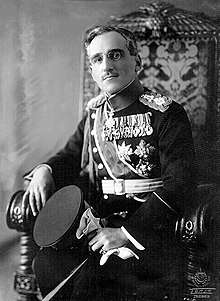6 January Dictatorship
The 6 January Dictatorship (Serbian: Шестојануарска диктатура / Šestojanuarska diktatura, Croatian: Šestosiječanjska diktatura, Slovene: Šestojanuarska diktatura) was a royal dictatorship established in the Kingdom of Serbs, Croats and Slovenes (Kingdom of Yugoslavia after 1929) by King Alexander I (r. 1921–34) with the ultimate goal to create the Yugoslav ideology and single Yugoslav nation. It lasted from 6 January 1929, when the king prorogued parliament and assumed control of the state, and ended with the 1931 Yugoslav Constitution.
History
In 1928, Croatian Peasant Party leader Stjepan Radić was assassinated in the Parliament of Yugoslavia by a Montenegrin Serb leader and People's Radical Party politician Puniša Račić, during a tense argument.[1]
Trying to reconcile ethnic tensions, especially between Serbian and Croatian politicians, Alexander introduced a dictatorship with the aim of establishing the Yugoslav ideology and single Yugoslav nation.[1][2][3][4][5][6][7]
The king abolished the Vidovdan Constitution, prorogued the National Assembly and introduced a personal dictatorship on 6 January 1929. The next day, general Petar Živković became prime minister, heading the regime's Yugoslav Radical Peasants' Democracy. On 11 January, the State Court for the Protection of the State was established in Belgrade.
The state was renamed to the Kingdom of Yugoslavia and was divided into new administrative divisions, called banovine (singular banovina). This decision was made following a proposal by the British ambassador to better decentralize the country, modeled on Czechoslovakia.[7]
Continuing his efforts to unify his subjects, Alexander outlawed all political parties based on ethnic, religious, or regional distinctions, reorganized the state administratively, and standardized legal systems, school curricula, and national holidays.[8]
On 20 April, the Croatian fascist Ustaše and Macedonian secessionist IMRO called for the independence of Croatia and Macedonia. On 25 April, Đuro Đaković, a prominent unionist and the first secretary of the Communist Party of Yugoslavia, was killed by Yugoslav policemen at the Yugoslav-Austrian border, Slovenia, after four days of torture and interrogation in a Zagreb police station. On 22 December, Croatian leader Vladko Maček was arrested.
After Alexander was assassinated, he was succeeded by the Yugoslav regency.
Notes
- Newman 2017.
- Troch 2017.
- Grgić 2018.
- Nielsen 2009.
- Dragnich 1991.
- Yeomans 2012, pp. 6.
- Pavlović 2012, pp. 512.
- "Alexander I, King of Yugoslavia". Encyclopædia Britannica. Retrieved 7 May 2020.
Sources
- Mrđenović, Dušan (1988). Ustavi i vlade Kneževine Srbije, Kraljevine Srbije, Kraljevine SHS i Kraljevine Jugoslavije, 1835-1941. Nova knj.
- Vucinich, Wayne S.; Tomasevich, Jozo (1969). Contemporary Yugoslavia: Twenty Years of Socialist Experiment. University of California Press. pp. 22–. GGKEY:5JR74ERLNET.
- Yeomans, Rory S (2012). Visions of Annihilation: The Ustasha Regime and the Cultural Politics of Fascism, 1941-1945. University of Pittsburgh Pre. ISBN 9780822977933.CS1 maint: ref=harv (link)
- Newman, John Paul (2017). "War Veterans, Fascism, and Para-Fascist Departures in the Kingdom of Yugoslavia, 1918–1941". Fascism. 6: 63. doi:10.1163/22116257-00601003.CS1 maint: ref=harv (link)
- Troch, Pieter (2017). "Yugoslavism between the world wars: indecisive nation building". Fascism. 38 (2): 227–244. doi:10.1080/00905990903517819.CS1 maint: ref=harv (link)
- Grgić, Stipica (2018). "Pantheon on a tablecloth: Yugoslav dictatorship and the confrontation of national symbols in Croatia (1929–1935)". The Journal of Nationalism and Ethnicity. 46 (3): 458–470. doi:10.1080/00905992.2017.1357029.CS1 maint: ref=harv (link)
- Nielsen, Christian Axboe (2009). "Policing Yugoslavism: Surveillance, Denunciations, and Ideology during King Aleksandar's Dictatorship, 1929-1934". East European Politics and Societies. 23 (1): 34–62. doi:10.1177/0888325408326789.CS1 maint: ref=harv (link)
- Dragnich, Alex N. (1991). "The Anatomy of a Myth: Serbian Hegemony". Slavic Review. 50 (3): 659–662. doi:10.2307/2499861. JSTOR 2499861.CS1 maint: ref=harv (link)
- Pavlović, Marko (2012). Časlav Ocić (ed.). "Jugoslovenska kraljevina prva evropska regionalna država" (PDF). Zbornik Matice srpske za društvene nauke. Novi Sad: Matica srpska. 141: 503–521. ISSN 0352-5732. Retrieved 27 April 2020.CS1 maint: ref=harv (link)
Further reading
- Stojkov, Todor. Opozicija u vreme šestojanuarske diktature 1929-1935. Prosveta, 1969.
- Gašparič, Jure. SLS pod kraljevo diktaturo: diktatura kralja Aleksandra in politika Slovenske ljudske stranke v letih 1929-1935. Modrijan, 2007.
- Imamović, Mustafa. Pravni položaj verskih zajednica za vreme šestojanuarske diktature. 1991
- Janjatović, Bosiljka. "O progonima hrvatskih političara u Zagrebu za vrijeme karađorđevićevske šestojanuarske diktature." Radovi Zavoda za hrvatsku povijest 26.1 (1993): 161-176.
- Janjatović, Bosiljka, and Petar Strčić. "Nekoliko spisa organa vlasti o komunistima na otoku Krku za šestojanuarske diktature." Vjesnik historijskih arhiva u Rijeci i Pazinu 16.1971) (1971): 91-126.
- Jerotijevic, Zoran. "Економски и политички узроци увођења Шестојануарског режима (Economic and Political Causes of the Introduction of the January Sixth Regime)." Ekonomika 60.2 (2014): 227-238.
- Kaučič, Domen. Odnos Slovencev do kralja Aleksandra I. Karađorđevića: odziv na politične poteze kraljevega dvora v času šestojanuarske diktature: diplomsko delo. Diss. D. Kaučič, 2015.
- Drakić, Gordana. "Arising of the Legal System in the Yugoslav State between the Two World Wars." Proceedings of Novi Sad Faculty of Law 42 (2008).

